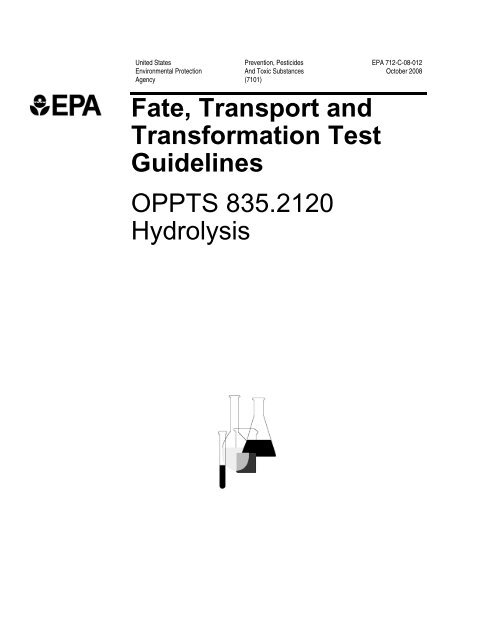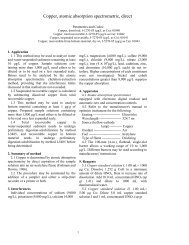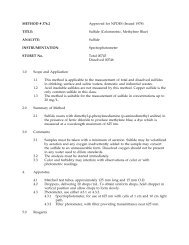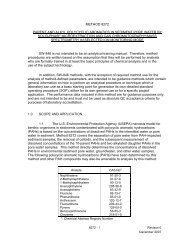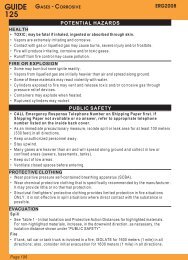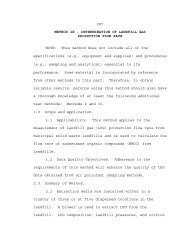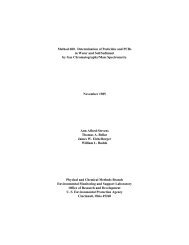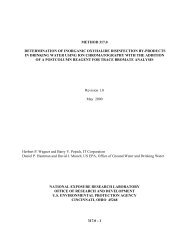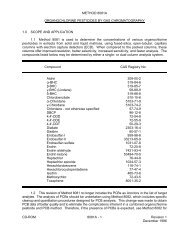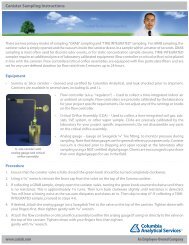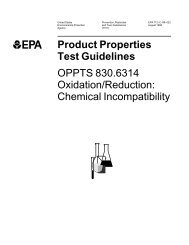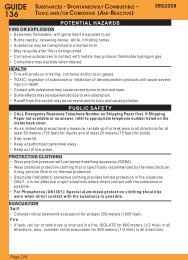View Actual EPA Method 835.2120 - Columbia Analytical Services
View Actual EPA Method 835.2120 - Columbia Analytical Services
View Actual EPA Method 835.2120 - Columbia Analytical Services
You also want an ePaper? Increase the reach of your titles
YUMPU automatically turns print PDFs into web optimized ePapers that Google loves.
United StatesEnvironmental ProtectionAgencyPrevention, PesticidesAnd Toxic Substances(7101)Fate, Transport andTransformation TestGuidelinesOPPTS <strong>835.2120</strong>Hydrolysis<strong>EPA</strong> 712-C-08-012October 2008
INTRODUCTIONThis guideline is one of a series of test guidelines that have beendeveloped by the Office of Prevention, Pesticides and Toxic Substances(OPPTS), United States Environmental Protection Agency for use in the testingof pesticides and toxic substances, and the development of test data to meet thedata requirements of the Agency under the Toxic Substances Control Act (TSCA)(15 U.S.C. 2601), the Federal Insecticide, Fungicide and Rodenticide Act(FIFRA) (7 U.S.C. 136, et seq.), and section 408 of the Federal Food, Drug andCosmetic (FFDCA) (21 U.S.C. 346a).OPPTS developed this guideline through a process of harmonization ofthe testing guidance and requirements that existed for the Office of PollutionPrevention and Toxics (OPPT) in Title 40, Chapter I, Subchapter R of the Codeof Federal Regulations (CFR), the Office of Pesticide Programs (OPP) inpublications of the National Technical Information Service (NTIS) and in theguidelines published by the Organization for Economic Cooperation andDevelopment (OECD).For additional information about OPPTS harmonized guidelines and toaccess this and other guidelines, please go to http://www.epa.gov/oppts andselect “Test <strong>Method</strong>s & Guidelines” on the left side menu.
OPPTS <strong>835.2120</strong> Hydrolysis.(a) Scope—(1) Applicability. This guideline is intended for use in meeting testingrequirements of the Federal Insecticide, Fungicide, and Rodenticide Act (FIFRA) (7 U.S.C.136, etseq.) and for testing pursuant to the Toxic Substances Control Act (TSCA) (15 U.S.C. 2601, et seq.)It describes procedures that, if followed, would result in data that would generally be of scientificmerit for the purposes described in paragraph (b) of this guideline.(2) Background. This harmonized OPPTS test guideline is based largely on OECDGuidelines for the Testing of Chemicals, OECD 111 Hydrolysis as a Function of pH, withclarifications derived from 40 CFR 796.3500 Hydrolysis as a Function of pH at 25 ºC and OPP 161-1 Hydrolysis studies (Pesticide Assessment Guidelines Subdivision N - Chemistry: EnvironmentalFate, <strong>EPA</strong> report 540/9-82-021), October 1982) for testing under TSCA and FIFRA, respectively.(b) Purpose. This guideline describes a laboratory test method to assess abiotic hydrolytictransformations of chemicals in aquatic systems at pH values normally found in the environment (pH4 – 9). Chemicals can enter surface waters by such routes as direct application, spray drift, run-off,drainage, waste disposal, industrial, domestic or agricultural effluent and atmospheric deposition andmay be transformed in those waters by chemical (e.g., hydrolysis, oxidation), photochemical and/ormicrobial processes. Experiments are performed to determine the rate of hydrolysis of the testsubstance as a function of pH and the identity or nature and rates of formation and decline ofhydrolysis products to which organisms may be exposed. Studies apply to chemicals which aredirectly applied to water or that are likely to reach the environment by the other routes described inthis paragraph.(c) Definitions.DT 50 (Disappearance time 50) is the time within which the concentration of the testsubstance is reduced by 50%; it is different from the half-life (t 0.5 ) when the reaction does not followfirst order kinetics.Half-life (t 0.5 ) is the time taken for 50% hydrolysis of a test substance when the reaction canbe described by first order kinetics: it is independent of the concentration.Hydrolysis is a reaction of a test substance RX with water, with the net exchange of thegroup X with OH at the reaction center: RX + HOH → ROH + HX.Hydrolysis products are all substances resulting from hydrolytic transformation reactions ofthe test substance.Test substance is any substance, whether the parent compound or relevant transformationproducts.Transformation products are all substances resulting from biotic or abiotic transformationreactions of the test substance.1
(d) Principle of the test. (1) Sterile aqueous buffer solutions of different pH values (pH 4, 7and 9) are treated with the test substance and incubated in the dark under controlled laboratoryconditions (at constant temperatures). After appropriate time intervals, buffer solutions are analyzedfor the test substance and for hydrolysis products. With labeled test substance (e.g., 14 C), a massbalance can be more easily established (see paragraphs (j)1 through (j)(5) of this guideline).(2) A tiered approach to testing is shown in Figure 1:(e) Special considerations. (1) The method is generally applicable to chemical substances(unlabeled or labeled) for which an analytical method with sufficient accuracy and sensitivity isavailable. It is applicable to slightly volatile and non-volatile compounds of sufficient solubility inwater. The test should not be applied to chemicals that are highly volatile from water (e.g.,2
fumigants, organic solvents) and thus cannot be kept in solution under the experimental conditionsof this test. The test may be difficult to conduct with substances of minimal solubility in water (seeparagraph (j)(6) of this guideline).(2) Before carrying out a hydrolysis test, the following information on the test substanceshould be available: solubility in water; solubility in organic solvents; vapor pressure; n-octanol/water partition coefficient; dissociation constant (pKa); and phototransformation rate inwater where appropriate.(3) <strong>Analytical</strong> methods for quantification of the test substance and, if it is relevant, foridentification and quantification of hydrolysis products in aqueous solutions should be available (seeparagraph (e)(4)(ii) of this guideline). Where possible, reference substances should be used for theidentification and quantification of hydrolysis products by spectroscopic and chromatographicmethods or other suitably sensitive methods.(4) Quality criteria. (i) Recovery. Analysis of, at least, duplicate buffer solutions or of theirextracts immediately after the addition of the test substance gives a first indication of therepeatability of the analytical method and of the uniformity of the application procedure for the testsubstance. Recoveries for later stages of the experiments are given by the respective mass balances(when labeled material is used). Recoveries should range from 90% to 110% for labeled and nonlabeledchemicals. In case it is technically difficult to reach this range, a recovery of 70% for nonlabeledchemicals is acceptable, but justification should be given.(ii) Repeatability and sensitivity of analytical method. (A) Repeatability of the analyticalmethod(s) used to quantify the test substance and hydrolysis products at later times can be checkedby duplicate analysis of the same buffer solutions (or of their extracts) after sufficient quantities ofhydrolysis products have formed for quantification.(B) The analytical method should be sufficiently sensitive to quantify test substanceconcentrations down to 10% or less of the initial concentration. If relevant, analytical methodsshould also be sufficiently sensitive to quantify any hydrolysis product representing 10% or more ofapplied (at any time during the study) down to 25% or less of its peak concentration.(C) For testing pesticides, identification and quantification of products of knowntoxicological or ecotoxicological concern, even if below 10% of the amount applied, should also beidentified.(iii) Confidence intervals for hydrolysis kinetic data. Confidence intervals should becomputed and presented for all regression coefficients, rate constants, half-lives, and any otherkinetic parameters (e.g., DT 50 ).(f) Test method. (1) Test substance. Non-labeled or labeled test substance can be used tomeasure the rate of hydrolysis. Labeled material is generally preferred for studying the pathway ofhydrolysis and for establishing mass balance; however, in special cases, labeling may not be3
absolutely necessary. 14 C-labeling is recommended but the use of other isotopes, such as 13 C, 15 N,3 H, may also be useful. As far as possible, the label should be positioned in the most stable part(s) ofthe molecule. For example, if the test substance contains one ring, this ring should be labeled; if thetest substance contains two or more rings, separate studies may be called for to evaluate the fate ofeach labeled ring and to obtain suitable information on formation of hydrolysis products. The purityof the test substance should be at least 95%.(2) Equipment and apparatus. (i) The study should be performed in glass containers (e.g.,test tubes, small flasks) under dark and sterile conditions, if necessary, unless preliminaryinformation (such as the n-octanol-water partition coefficient) indicates that the test substance mayadhere to glass. In such cases, alternative materials (such as Teflon) may have to be considered. Itmay also be possible to alleviate the problem of adherence to glass by using one or more of thefollowing methods:(A) Determine the mass of test substance and hydrolysis products sorbed to the test vessel.(B) Use of an ultrasonic bath.(C) Ensure a solvent wash of all glassware at each sampling interval.(D) Use of formulated products.(E) Use an increased amount of co-solvent for addition of test substance to the system; if aco-solvent is used it should be a co-solvent that does not hydrolyze the test substance.(ii) Temperature-controlled water bath shakers or thermostatically-controlled incubators forincubation of the various test solutions are normally used.(iii) Standard laboratory equipment is used, including, in particular, the following:(A) pH meter.(B) <strong>Analytical</strong> instruments such as GC, HPLC, TLC equipment, including the appropriatedetection systems for analyzing radiolabeled and non-labeled substances or inverse isotopes dilutionmethod.(C) Instruments for identification purposes (e.g., MS, GC-MS, HPLC-MS, NMR, etc.).(D) Liquid scintillation counter.(E) Separating funnels for liquid-liquid extraction.(F) Instrumentation for concentrating solutions and extracts (e.g., rotating evaporator).4
(G) Temperature control devise (e.g., water bath).(iv) Chemical reagents include, for example:(A) Organic solvents, analytical grade, such as hexane, dichloromethane, etc.(B) Scintillation liquid.(C) Buffer solutions (for details see paragraph (f)(4)(i) of this guideline).(v) All glassware, reagent-grade water and buffer solutions used in the hydrolysis testsshould be sterilized.(3) Application of test substance. (i) The test substance should be applied as aqueoussolution into the different buffer solutions. If it is necessary for adequate dissolution, the use of lowamounts of water miscible solvents (such as acetonitrile, acetone, ethanol) is permitted forapplication and distribution of the test substance but this should not normally exceed 1% v/v. In casea higher concentration of solvents is considered (e.g., in the case of poorly soluble test substances),this could only be allowed when it can be shown that the solvent has no effect on the hydrolysis ofthe test substances.(ii) The use of formulated product is not routinely recommended, as it cannot be excludedthat the formulation ingredients may influence the hydrolysis process. However, for poorly watersolubletest substances or for substances that adhere to glass (see paragraph (f)(2)(i) of thisguideline), the use of formulated material may be an appropriate alternative.(iii) One concentration of the test substance should be used; it should not exceed 0.01 M orhalf of the saturation concentration (see Figure 1 in paragraph (d)(2) of this guideline).(4) Buffer solutions. (i) The hydrolysis test should be performed at pH values of 4, 7 and 9.For this purpose, buffer solutions should be prepared using reagent grade chemicals and water.Some useful buffer systems are presented in Tables 1 - 4. It should be noted that the buffer systemused may influence the rate of hydrolysis and where this is observed an alternate buffer systemshould be employed. (Mabey and Mill recommend the use of borate or acetate buffers instead ofphosphate (see paragraph (j)(7) of this guideline).5
Table 1. Buffer mixtures of Clark and LubsCompositionpH0.2 N HC1 AND 0.2 N KC1 AT 20 °C47.5 ml. HC1 + 25 ml. KC1 dil. to 100 ml 1.032.25 ml. HC1 + 25 ml. KC1 dil. to 100 ml 1.220.75 ml. HC1 + 25 ml. KC1 dil. to 100 ml 1.413.15 ml. HC1 + 25 ml. KC1 dil. to 100 ml 1.68.3 ml. HC1 + 25 ml. KC1 dil. to 100 ml 1.85.3 ml. HC1 + 25 ml. KC1 dil. to 100 ml 2.03.35 ml. HC1 + 25 ml. KC1 dil. to 100 ml 2.20.1 M potassium biphthalate + 0.1 N HC1 at 20 °C46.70 ml. 0.1 N HC1 + 50 ml. biphthalate to 100 ml 2.239.60 ml. 0.1 N HC1 + 50 ml. biphthalate to 100 ml 2.432.95 ml. 0.1 N HC1 + 50 ml. biphthalate to 100 ml 2.626.42 ml. 0.1 N HC1 + 50 ml. biphthalate to 100 ml 2.820.32 ml. 0.1 N HC1 + 50 ml. biphthalate to 100 ml 3.014.70 ml. 0.1 N HC1 + 50 ml. biphthalate to 100 ml 3.29.90 ml. 0.1 N HC1 + 50 ml. biphthalate to 100 ml 3.45.97 ml. 0.1 N HC1 + 50 ml. biphthalate to 100 ml 3.62.63 ml. 0.1 N HC1 + 50 ml. biphthalate to 100 ml 3.80.1 M potassium biphthalate + 0.1 N NaOH at 20 °C0.40 ml. 0.1 N NaOH +50 ml. biphthalate to 100 ml 4.03.70 ml. 0.1 N NaOH +50 ml. biphthalate to 100 ml 4.27.50 ml. 0.1 N NaOH +50 ml. biphthalate to 100 ml 4.412.15 ml. 0.1 N NaOH +50 ml. biphthalate to 100 ml 4.617.70 ml. 0.1 N NaOH +50 ml. biphthalate to 100 ml 4.823.85 ml. 0.1 N NaOH +50 ml. biphthalate to 100 ml 5.029.95 ml. 0.1 N NaOH +50 ml. biphthalate to 100 ml 5.2CompositionpH35.45 ml. 0.1 N NaOH +50 ml. biphthalate to 100 ml 5.439.85 ml. 0.1 N NaOH +50 ml. biphthalate to 100 ml 5.643.00 ml. 0.1 N NaOH +50 ml. biphthalate to 100 ml 5.80.1 M monopotassium phosphate + 0.1 N NaOH at 20 °C5.70 ml. 0.1 N NaOH + 50 ml. phosphate to 100 ml 6.08.60 ml. 0.1 N NaOH + 50 ml. phosphate to 100 ml 6.212.60 ml. 0.1 N NaOH + 50 ml. phosphate to 100 ml 6.417.80 ml. 0.1 N NaOH + 50 ml. phosphate to 100 ml 6.623.45 ml. 0.1 N NaOH + 50 ml. phosphate to 100 ml 6.829.63 ml. 0.1 N NaOH + 50 ml. phosphate to 100 ml 7.035.00 ml. 0.1 N NaOH + 50 ml. phosphate to 100 ml 7.239.50 ml. 0.1 N NaOH + 50 ml. phosphate to 100 ml 7.442.80 ml. 0.1 N NaOH + 50 ml. phosphate to 100 ml 7.645.20 ml. 0.1 N NaOH + 50 ml. phosphate to 100 ml 7.846.80 ml. 0.1 N NaOH + 50 ml. phosphate to 100 ml 8.00.1 M H 3 B0 3 in 0.1 M KC1 + 0.1 N NaOH at 20 °C2.61 ml. 0.1 N NaOH + 50 ml. boric acid to 100 ml 7.83.97 ml. 0.1 N NaOH + 50 ml. boric acid to 100 ml 8.0CompositionpH6
5.90 ml. 0.1 N NaOH + 50 ml. boric acid to 100 ml 8.28.50 ml. 0.1 N NaOH + 50 ml. boric acid to 100 ml 8.412.00 ml. 0.1 N NaOH + 50 ml. boric acid to 100 ml 8.616.30 ml. 0.1 N NaOH + 50 ml. boric acid to 100 ml 8.821.30 ml. 0.1 N NaOH + 50 ml. boric acid to 100 ml 9.026.70 ml. 0.1 N NaOH + 50 ml. boric acid to 100 ml 9.232.00 ml. 0.1 N NaOH + 50 ml. boric acid to 100 ml 9.436.85 ml. 0.1 N NaOH + 50 ml. boric acid to 100 ml 9.640.80 ml. 0.1 N NaOH + 50 ml. boric acid to 100 ml 9.843.90 ml. 0.1 N NaOH + 50 ml. boric acid to 100 ml 10.0Note: The pH values reported in these tables have been calculated from the potential measurements using Sörensen’sstandard equations (1909), (see paragraph (j)(8) of this guideline). The corresponding pH values are 0.04 units higherthan the tabulated values. See paragraph (f)(7) of this guideline.Table 2. Citrate buffers of Kolthoff and VleeschhouwerCompositionpH0.1 M monopotassium citrate and 0.1 N HC1 at 18 °C*49.7 ml. 0.1 N HC1 + 50 ml. citrate to 100 ml 2.243.4 ml. 0.1 N HC1 + 50 ml. citrate to 100 ml 2.436.8 ml. 0.1 N HC1 + 50 ml. citrate to 100 ml 2.630.2 ml. 0.1 N HC1 + 50 ml. citrate to 100 ml 2.823.6 ml. 0.1 N HC1 + 50 ml. citrate to 100 ml 3.017.2 ml. 0.1 N HC1 + 50 ml. citrate to 100 ml 3.210.7 ml. 0.1 N HC1 + 50 ml. citrate to 100 ml 3.44.2 ml. 0.1 N HC1 + 50 ml. citrate to 100 ml 3.60.1 M monopotassium citrate and 0.1 N NaOH at 18 °C*2.0 ml. 0.1 N NaOH + 50 ml. citrate to 100 ml 3.89.0 ml. 0.1 N NaOH + 50 ml. citrate to 100 ml 4.016.3 ml. 0.1 N NaOH + 50 ml. citrate to 100 ml 4.223.7 ml. 0.1 N NaOH + 50 ml. citrate to 100 ml 4.431.5 ml. 0.1 N NaOH + 50 ml. citrate to 100 ml 4.639.2 ml. 0.1 N NaOH + 50 ml. citrate to 100 ml 4.846.7 ml. 0.1 N NaOH + 50 ml. citrate to 100 ml 5.054.2 ml. 0.1 N NaOH + 50 ml. citrate to 100 ml 5.261.0 ml. 0.1 N NaOH + 50 ml. citrate to 100 ml 5.468.0 ml. 0.1 N NaOH + 50 ml. citrate to 100 ml 5.674.4 ml. 0.1 N NaOH + 50 ml. citrate to 100 ml 5.881.2 ml. 0.1 N NaOH + 50 ml. citrate to 100 ml 6.0*Add tiny crystal of thymol or a similar substance to prevent growth of molds7
Table 3. Borate mixtures of SorensenCompositionSörensenWalbum, pH atml. Borax ml. HC1/NaOH 18 °C 10 °C 40 °C 70 °C0.05 M borax + 0.1 N HC15.255.505.756.006.507.007.508.008.509.009.5010.004.754.504.254.003.503.002.502.001.501.000.500.007.627.948.148.298.518.088.808.919.019.099.179.247.647.988.178.328.548.728.848.969.069.149.229.307.557.868.068.198.408.568.678.778.868.949.019.087.477.767.958.088.288.408.508.598.678.748.808.860.05 M borax + 0.1 N NaOH10.09.08.07.06.00.01.02.03.04.09.249.369.509.689.979.309.429.579.7610.069.089.189.309.449.678.868.949.029.129.28Table 4. Posphate mixtures of SorensenCompositionpH0.0667 M Monopotassium phosphate + 0.0667 M Disodium phosphate at 20 °C99.2 ml. KH 2 PO 4 + 0.8 ml Na 2 HPO 4 5.098.4 ml. KH 2 PO 4 + 1.6 ml Na 2 HPO 4 5.297.3 ml. KH 2 PO 4 + 2.7 ml Na 2 HPO 4 5.495.5 ml. KH 2 PO 4 + 4.5 ml Na 2 HPO 4 5.692.8 ml. KH 2 PO 4 + 7.2 ml Na 2 HPO 4 5.888.9 ml. KH 2 PO 4 + 11.1 ml Na 2 HPO 4 6.083.0 ml. KH 2 PO 4 + 17.0 ml Na 2 HPO 4 6.275.4 ml. KH 2 PO 4 + 24.6 ml Na 2 HPO 4 6.465.3 ml. KH 2 PO 4 + 34.7 ml Na 2 HPO 4 6.653.4 ml. KH 2 PO 4 + 46.6 ml Na 2 HPO 4 6.841.3 ml. KH 2 PO 4 + 58.7 ml Na 2 HPO 4 7.029.6 ml. KH 2 PO 4 + 70.4 ml Na 2 HPO 4 7.219.7 ml. KH 2 PO 4 + 80.3 ml Na 2 HPO 4 7.412.8 ml. KH 2 PO 4 + 87.2 ml Na 2 HPO 4 7.67.4 ml. KH 2 PO 4 + 92.6 ml Na 2 HPO 4 7.83.7 ml. KH 2 PO 4 + 96.3 ml Na 2 HPO 4 8.0(ii) The pH of each buffer solution should be checked with a calibrated pH meter to aprecision of at least 0.1 at the required temperature.8
(5) Test conditions. (i) Test temperature. (A) The hydrolysis experiments should becarried out at constant temperatures. For extrapolation purposes, it is important to maintain thetemperature to at least ± 0.5 °C.(B) A preliminary test (Tier 1) should be conducted at a temperature of 50 °C if thehydrolytic behavior of the test substance is unknown. Higher tier kinetic tests should be carried outwith a minimum of three temperatures (including the test at 50 ºC) unless the test substance is stableto hydrolysis as determined by the Tier 1 testing. A suggested temperature range is 10-70 °C(preferably with at least one temperature below 25 °C utilized), which will encompass the reportingtemperature of 25°C and most of the temperatures encountered in the field.(C) For testing pesticides, one test temperature at 25 °C is preferred over obtaining thehydrolytic rate at 25 °C through extrapolation using the Arrhenius equation.(ii) Light and oxygen. All hydrolysis tests should be conducted using any suitable methodto avoid photolytic effects. All suitable measures should be taken to avoid oxygen (e.g., by bubblinghelium, nitrogen or argon for 5 minutes before preparation of the solution).(iii) Test duration. The preliminary test should be carried out for 5 days whereas the higherTier tests should be conducted until 90% hydrolysis of the test substance or for 30 days whichevercomes first.(6) Preliminary test (Tier 1). The preliminary test is performed at 50 ± 0.5 °C and pH 4.0,7.0 and 9.0. If less than 10% of hydrolysis is observed after 5 days (t0.5 25°C > 1 year), the testsubstance is considered hydrolytically stable and, normally, no additional testing is necessary. If thesubstance is known to be unstable at environmentally relevant temperatures, the preliminary test isnot required. The analytical method should be sufficiently precise and sensitive to detect a reductionof 10% in the initial concentration. (Information regarding stability may come from other sourcessuch as hydrolysis data of structurally similar compounds from the literature or from otherpreliminary, semi-quantitative hydrolysis tests with the test substance at an earlier developmentstage.)(7) Hydrolysis of unstable substances (Tier 2). The higher Tier (advanced) test should beperformed at the pH values at which the test substance was found unstable as defined by thepreliminary test above. The buffered solutions of the test substance should be thermostated at theselected temperatures. To test for first-order behavior, each reaction solution should be analyzed intime intervals which provide a minimum of six spaced data points normally between 10% and 90%hydrolysis of the test substance. Individual replicate test samples (a minimum of duplicate samplescontained in separate reaction vessels) should be removed and the contents analyzed at each of atleast six sampling times (for a minimum of twelve replicate data points). The use of a single bulksample from which individual aliquots of the test solution are removed at each sampling interval isconsidered to be inadequate, as it does not allow for the analysis of data variability and it may leadto problems with contamination of the test solution. Sterility confirmation tests should be conducted9
at the end of the higher Tier test (i.e., at 90% hydrolysis or 30 days). However, if no degradation(i.e., transformation) is observed, sterility tests are not considered necessary.(8) Identification of hydrolysis products (Tier 3). (i) Any major hydrolysis products, atleast those representing ≥ 10% of the applied dose, should be identified by appropriate analyticalmethods.(ii) For testing pesticides, identification and quantification of products of knowntoxicological or ecotoxicological concern, even if below 10% of the amount applied, should also beidentified.(9) Optional tests. Additional tests at pH values other than 4, 7 and 9 may be needed for ahydrolytically unstable test substance. For example, for physiological purposes a test under moreacidic conditions (e.g., pH 1.2) may be called for employing a single physiologically relevanttemperature (37°C).(g) Treatment of results. (1) The amounts of test substance and of hydrolysis products, ifrelevant, should be given as % of applied initial concentration and, where appropriate, as mg/L foreach sampling interval and for each pH and test temperature. In addition, a mass balance should begiven in percentage of the applied initial concentration when labeled test substance has been used.(2) A graphical presentation of the log-transformed data of the test substance concentrationsagainst time should be reported. Any major hydrolysis products, at least those representing ≥ 10%of the applied dose, should be identified and their log-transformed concentrations should also beplotted in the same manner as the parent substance to show their rates of formation and decline.(3) More accurate determinations of half-lives or DT 50 values should be obtained by applyingappropriate kinetic model calculations. The half-life and/or DT 50 values (including confidencelimits) should be reported for each pH and temperature together with a description of the model usedthe order of kinetics and the coefficient of determination (r 2 ). If appropriate, the calculations shouldalso be applied to the hydrolysis products.(4) In the case of rate studies carried out at different temperatures, the pseudo first-orderhydrolysis rate constants (k obs ) should be described as a function of temperature. The calculationshould be based on both the separation of k obs into rate constants for acid-catalyzed, neutral, andbase catalyzed hydrolysis (k H , k neutral , and k OH respectively) and the Arrhenius equation:kobs= kH[H+] + kneutral+ kOH[OH−] =∑−Aiei=H,neutral,OHB /Tiwhere A i and B i are regression constants from the intercept and slope, respectively, of thebest fit lines generated from linearly regressing ln k i against the reciprocal of the absolutetemperature in Kelvin (T). Through the use of the Arrhenius relationships for acid, neutral and base10
catalyzed hydrolysis, pseudo first-order rate constants, and thus half-lives can be calculated for othertemperatures for which the direct experimental determination of a rate constant is not practicable(see paragraph (j)(9) of this guideline).(h) Interpretation and evaluation of results. Most hydrolysis reactions follow apparentfirst order reaction rates and, therefore, half-lives are independent of the concentration. This usuallypermits the application of laboratory results determined at 10 -2 to 10 -3 M to environmental conditions(≤ 10 -6 M) (see paragraph (j)(9) of this guideline). Several examples of good agreement betweenrates of hydrolysis measured in both pure and natural waters for a variety of chemicals were reportedby Mabey and Mill (see paragraph (j)(7) of this guideline), provided both pH and temperature hadbeen measured.(i) Test report. The report should include the following information: (1) Test substance:(A) Common name, chemical name, CAS number, structural formula (indicating position oflabel when radiolabeled material is used) and relevant physical-chemical properties (see paragraph(e)(2) of this guideline);(B) Purity (impurities) of test substance.(C) Label purity of labeled chemical and molar activity (where appropriate).(2) Buffer solutions: (A) Dates and details of preparation.(B) Buffers and waters used.(C) Molarity and pH of buffer solutions.(3) Test conditions: (A) Dates of the performance of the studies.(B) Amount of test substance applied.(C) <strong>Method</strong> and solvents (type and amount) used for application of the test substance.(D) Volume of buffered test substance solutions incubated.(E) Description of the incubation system used.(F) pH and temperature during the study.(G) Sampling times.(H) <strong>Method</strong>(s) of extraction.11
(I) <strong>Method</strong>s for quantification and identification of the test substance and its hydrolysisproducts in the buffer solutions.(J) Number of replicates.(4) Results. (A) Repeatability and sensitivity of the analytical methods used.(B) Recoveries (% values for a valid study are given in paragraph (e)(4)(i) of this guideline).(C) Replicate data and means in a tabular form.(D) Mass balance during and at the end of the studies (when labeled test substance is used).(E) Results of preliminary test.(F) Discussion and interpretation of results.(G) All original data and figures.(5) Tables and figures. The following information should be included when hydrolysis rateis determined:(A) Plots of concentrations versus time for the test substances and, where appropriate, for thehydrolysis products at each pH value and temperature.(B) Tables of results of Arrhenius equation for the temperature 20 °C/25 °C, with pH,rateconstant [h -1 or day -1 ], half-life or DT 50 , temperatures [°C] including confidence limits and thecoefficients of correlation (r 2 ) or comparable information.(C) Proposed pathway of hydrolysis.(j) References. The following references should be consulted for additional backgroundinformation on this guideline:(1) Agriculture Canada (1987). Environmental Chemistry and Fate Guidelines forregistration of pesticides in Canada.(2) European Union (EU) (1995). Commission Directive 95/36/EC amending CouncilDirective 91/414/EEC concerning the placing of plant protection products on the market. AnnexV: Fate and Behaviour in the Environment.(3) Dutch Commission for Registration of Pesticides (1991). Application for registrationof a pesticide. Section G: Behaviour of the product and its metabolites in soil, water and air.12
(4) BBA (1980). Merkblatt Nr. 55, Teil I und II: Prüfung des Verhaltens vonPflanzenbehandlungsmitteln im Wasser (October 1980).(5) SETAC (1995). Procedures for Assessing the Environmental Fate and Ecotoxicity ofPesticides.Mark R. Lynch, Ed.(6) OECD (2000). Guidance document on aquatic toxicity testing of difficult substancesand mixtures, OECD Environmental Health and Safety Publications Series on Testing andAssessment No.23.(7) Mabey, W. and Mill, T. (1978). Critical review of hydrolysis of organic compoundsin water under environmental conditions. J. Phys. Chem. Ref. Data 7, 383-415.(8) Sörensen, S.P.L. (1909). Enzymstudien II. Mitteilung. Uber die Messung und dieBedentung der Wasserstoffionenkonzentration bie enzymatischen Prozessen. Biochem. Z., 21,131-304.(9) Nelson, H, Laskowski D, Thermes S, and Hendley P. (1997) Recommended changesin pesticide fate study guidelines for improving input to computer models. (Text version of oralpresentation at the 14th Annual Meeting of the Society of Environmental Toxicology andChemistry, Dallas TX, November 1993).13


